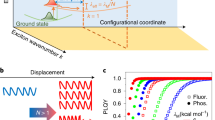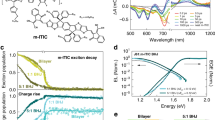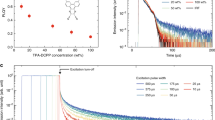Abstract
Electroluminescence in organic light-emitting diodes arises from a charge-transfer reaction between the injected positive and negative charges by which they combine to form singlet excitons that subsequently decay radiatively. The quantum yield of this process (the number of photons generated per electron or hole injected) is often thought1 to have a statistical upper limit of 25 per cent. This is based on the assumption that the formation cross-section of singlet excitons, σS, is approximately the same as that of any one of the three equivalent non-radiative triplet exciton states, σT; that is, σS/σT ≈ 1. However, recent experimental2 and theoretical3 work suggests that σS/σT may be greater than 1. Here we report direct measurements of σS/σT for a large number of π-conjugated polymers and oligomers. We have found that there exists a strong systematic, but not monotonic, dependence of σS/σT on the optical gap of the organic materials. We present a detailed physical picture of the charge-transfer reaction for correlated π-electrons, and quantify this process using exact valence bond calculations. The calculated σS/σT reproduces the experimentally observed trend. The calculations also show that the strong dependence of σS/σT on the optical gap is a signature of the discrete excitonic energy spectrum, in which higher energy excitonic levels participate in the charge recombination process.
This is a preview of subscription content, access via your institution
Access options
Subscribe to this journal
Receive 51 print issues and online access
$199.00 per year
only $3.90 per issue
Buy this article
- Purchase on Springer Link
- Instant access to full article PDF
Prices may be subject to local taxes which are calculated during checkout



Similar content being viewed by others
References
Friend, R. H. et al. Electroluminescence in conjugated polymers. Nature 397, 121–128 ( 1999).
Cao, Y., Parker, I. D., Yu, G., Zhang, C. & Heeger, A. J. Improved quantum efficiency for electroluminescence in semiconducting polymers. Nature 397, 414–417 (1999).
Shuai, Z., Beljonne, D., Silbey, R. J. & Bredas, J. L. Singlet and triplet exciton formation rates in conjugated polymer light-emitting diodes. Phys. Rev. Lett. 84, 131– 134 (2000).
Campbell, D. K., Bishop, A. R. & Fesser, K. Polarons in quasi-one-dimensional systems. Phys. Rev. B 26, 6862–6874 (1982).
Soos, Z. G. & Ramasesha, S. Valence bond theory of linear Hubbard and Pariser-Parr-Pople models. Phys. Rev. B 29, 5410–5422 (1984).
Lavrentiev, M. Yu., Barford, W., Martin, S. J., Daly, H. & Bursill, R. J. Theoretical investigation of the low-lying electronic structure of poly(p-phenylene vinylene). Phys. Rev. B 59, 9987–9994 (1999).
Rohlfing, M. & Louie, S. G. Optical excitations in conjugated polymers. Phys. Rev. Lett. 82, 1959– 1962 (1999).
Monkman, A. P. et al. The triplet state of the ladder-type methyl-poly(p-phenylene) as seen by pulse radiolysis-energy transfer. Chem. Phys. Lett. 327, 111–116 ( 2000).
Kim, J., Ho, P. K. H., Greenham, N. C. & Friend, R. H. Electroluminescence emission pattern of organic light-emitting diodes: Implications for device efficiency calculations. J. Appl. Phys. 88, 1073–1081 (2000).
Vardeny, Z. V. & Wei, X. in Handbook of Conducting Polymers II (eds Skotheim, T. A., Elsenbaumer, R. L. & Reynolds, J. R.) 639–666 (Marcel Dekker, New York, 1997).
Graupner, W. et al. Direct observation of ultrafast field-induced charge generation in ladder-type poly(para-phenylene). Phys. Rev. Lett. 81, 3259–3262 (1998).
Wohlgenannt, M., Graupner, W., Leising, G. & Vardeny, Z. V. Photogeneration and recombination processes of neutral and charged excitations in films of a ladder-type poly(para-phenylene). Phys. Rev. B 60, 5321–5330 (1999).
Soos, Z. G., Ramasesha, S. & Galvão, D. S. Band to correlated crossover in alternating Hubbard and Pariser-Parr-Pople chains: Nature of the lowest singlet excitation of conjugated polymers. Phys. Rev. Lett. 71, 1609–1612 (1993).
Pariser, R. & Parr, R. G. A semi-empirical theory of the electronic spectra and electronic structure of complex unsaturated molecules II. J. Chem. Phys. 21, 767–776 (1953).
Pople, J. A. Electron interaction in unsaturated hydrocarbons. Trans. Faraday Soc. 49, 1375–1385 ( 1953).
Campbell, D. K., Gammel, J. T. & Loh, E. Y. Bond-charge Coulomb repulsion in Peierls-Hubbard models. Phys. Rev. B 38, 12043– 12046 (1988).
Gallagher, F. & Mazumdar, S. Excitons and optical absorption in one-dimensional extended Hubbard models with short- and long-range interactions. Phys. Rev. B 56, 15025– 15039 (1997).
Acknowledgements
We thank E.J.W. List for supplying the mLPPP polymer, and X.M. Jiang and E.J.W. List for their support in performing the experiments. The work at the University of Utah was supported in part by the DOE and the NSF. Work in Arizona was partially supported by the ONR through the MURI centre (CAMP) at the University of Arizona. Work in Bangalor was funded by CSIR, India.
Author information
Authors and Affiliations
Corresponding author
Supplementary information
Rights and permissions
About this article
Cite this article
Wohlgenannt, M., Tandon, K., Mazumdar, S. et al. Formation cross-sections of singlet and triplet excitons in π-conjugated polymers. Nature 409, 494–497 (2001). https://doi.org/10.1038/35054025
Received:
Accepted:
Issue Date:
DOI: https://doi.org/10.1038/35054025
This article is cited by
-
Singlet Exciton Fraction in Electroluminescence from Conjugated Polymer
Scientific Reports (2017)
-
Effect of the Pauli exclusion principle on the singlet exciton yield in conjugated polymers
Applied Physics A (2016)
-
Highly Efficient Photon Upconversion in Self-Assembled Light-Harvesting Molecular Systems
Scientific Reports (2015)
-
Direct monitoring of bias-dependent variations in the exciton formation ratio of working organic light emitting diodes
Scientific Reports (2015)
-
The spin-Dicke effect in OLED magnetoresistance
Nature Physics (2015)
Comments
By submitting a comment you agree to abide by our Terms and Community Guidelines. If you find something abusive or that does not comply with our terms or guidelines please flag it as inappropriate.



